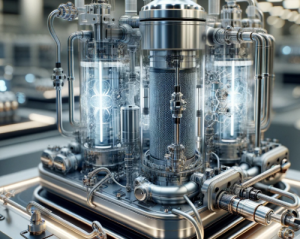Introduction
Precious metal catalysts play a crucial role in various industries, often increasing the efficiency, selectivity, and speed of these processes. Platinum, palladium, rhodium, ruthenium, and other precious metals are highly valued in catalytic applications for their remarkable activity and stability. From industrial chemical production to environmental protection and energy conversion, precious metal catalysts are indispensable in modern technology.
Key Precious Metals Used in Catalysts
Here are the key precious metals commonly used in catalysts:
– Platinum (Pt): Platinum is known for its outstanding catalytic activity and is widely used in chemical processes, fuel cells, and automotive applications.
– Palladium (Pd): Palladium plays a crucial role in catalyzing hydrogenation and dehydrogenation reactions, making it essential in the chemical industry.
– Rhodium (Rh): Often combined with platinum and palladium, rhodium is highly effective in automotive catalytic converters and various organic transformations.
– Ruthenium (Ru): Ruthenium-based catalysts are utilized in hydrogenation reactions, ammonia synthesis, and solar energy applications.
– Iridium (Ir): Iridium catalysts excel in hydrogenation reactions and are increasingly used in green energy technologies.
Applications of Precious Metal Catalysts
1. Automotive Catalytic Converters
One of the most common applications of precious metal catalysts is in automotive catalytic converters, which help reduce harmful emissions from internal combustion engines. Platinum, palladium, and rhodium are used to convert toxic gases like carbon monoxide (CO), hydrocarbons (HC), and nitrogen oxides (NOx) into less harmful substances such as carbon dioxide (CO₂), nitrogen (N₂), and water vapor. These catalysts play a critical role in meeting stringent environmental regulations.

2. Chemical and Petrochemical Industry
Precious metal catalysts are widely used in chemical reactions such as hydrogenation, oxidation, and reforming processes. For instance:
– Platinum and Palladium: These are used in hydrogenation reactions to produce various chemicals, including fuels, lubricants, and polymers. Palladium is also central to cross-coupling reactions like the Heck and Suzuki reactions, important in fine chemical and pharmaceutical synthesis.
– Rhodium: Used in the production of acetic acid through the Monsanto process and in the hydroformylation of olefins to produce aldehydes, rhodium is essential for high-value chemical manufacturing.
– Ruthenium: Ruthenium catalysts are often used in ammonia synthesis (Haber process) and in olefin metathesis reactions, contributing to the production of fertilizers and specialty chemicals.
3. Pharmaceutical Industry
Precious metal catalysts, particularly palladium and platinum, are essential in the pharmaceutical industry for the production of active pharmaceutical ingredients (APIs). The high selectivity and efficiency of these catalysts enable the production of complex organic molecules required for drugs, ensuring purity and minimizing side reactions. Palladium catalysts are especially important in coupling reactions used to form carbon-carbon bonds in drug synthesis.
4. Fuel Cells
Platinum is the primary catalyst used in hydrogen fuel cells, where it facilitates the reaction between hydrogen and oxygen to generate electricity. This technology is key to clean energy production, as fuel cells provide a highly efficient and environmentally friendly way to generate power for electric vehicles, portable electronics, and backup power systems. The catalytic activity of platinum helps split hydrogen molecules into protons and electrons, a critical step in fuel cell operation.

5. Hydrogen Production and Purification
Precious metal catalysts are vital in hydrogen production processes such as steam methane reforming (SMR) and water electrolysis. Platinum and ruthenium are used in electrolyzers that split water into hydrogen and oxygen, providing a clean way to produce hydrogen fuel. Palladium-based membranes are also used in hydrogen purification, ensuring the high purity of hydrogen for industrial and energy applications.
6. Environmental Protection and Pollution Control
Beyond automotive catalytic converters, precious metal catalysts are used in industrial settings to reduce emissions from chemical plants, refineries, and power plants. Catalysts containing platinum, rhodium, and palladium are employed in systems designed to remove NOx, sulfur compounds, and volatile organic compounds (VOCs) from exhaust gases, contributing to cleaner air and reduced environmental impact.
7. Renewable Energy and Green Chemistry
Precious metal catalysts, particularly ruthenium and iridium, are making significant strides in renewable energy applications, including solar energy harvesting and energy storage. These catalysts are employed in electrolyzers and fuel cells, playing a crucial role in the development of green hydrogen as an alternative fuel source. Additionally, they are essential for processes aimed at converting biomass into biofuels and valuable chemicals, supporting the shift toward sustainable energy systems.

Conclusion
Precious metal catalysts are central to a wide array of industries, from automotive emission control to chemical production and renewable energy. Their ability to speed up reactions while remaining stable under extreme conditions makes them indispensable in modern technologies.
As environmental regulations tighten and demand for cleaner energy grows, the role of these catalysts will only continue to expand, driving innovations in green chemistry and sustainable industrial practices. For more information, please check Advanced Refractory Metals.
